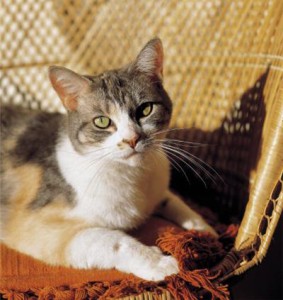 This is a fantastic article I discovered to help minimize cat shedding throughout your home. It gives great tips to preventing loose cat hair that unknowingly accumulates around the house to a minimum on upholstery and furnishings. I can truly relate to this article as I recently had a house guest come over who was wearing a black dress, as she was leaving I noticed the backside of her dress, was no longer black, ugh! I couldn’t let her leave like that, so I ran to my stash of lint rollers and I proceeded to roll her backside until it was black again!! Wow, how embarrasing for me and her, I can’t wait to implement these tips!!
This is a fantastic article I discovered to help minimize cat shedding throughout your home. It gives great tips to preventing loose cat hair that unknowingly accumulates around the house to a minimum on upholstery and furnishings. I can truly relate to this article as I recently had a house guest come over who was wearing a black dress, as she was leaving I noticed the backside of her dress, was no longer black, ugh! I couldn’t let her leave like that, so I ran to my stash of lint rollers and I proceeded to roll her backside until it was black again!! Wow, how embarrasing for me and her, I can’t wait to implement these tips!!
Cat Shedding 101 – Controlling the Fallout
by Kim W. TraffLiving with four spoiled housecats has taught me a thing or two about dealing with the ever-present issue of cat hair. The problem became all too apparent – in one of those humiliating ways – when a guest stood up from our dinner table one evening with what appeared to be a “fluffy cottontail” on his behind! Since then I have armed myself with the knowledge and devices to rid my home of cat hair. Well at least a substantial amount of cat hair; enough to ensure that no one has to worry about looking as if they have grown another appendage while visiting my home.
Shedding is a process that removes dead hair from a cat’s body, allowing room for new hair growth. A healthy coat is essential to the well-being of your cat. The coat provides protection from the elements, including UV rays, as well as protection from physical trauma. In addition, the process of shedding helps regulate a cat’s body temperature. Cats that frequent the outdoors typically shed more during the spring and summer, and less during the fall and winter months. Surprisingly, this is not due to the fluctuations in temperature but rather the amount of exposure to natural light, known as photoperiod. Indoor cats typically shed about the same during the year because they are primarily exposed to artificial light, which makes their bodies lose track of the seasonal changes.
Keep in mind that while shedding is a healthy and normal process, sudden excessive shedding could be a reason for concern. There are a number of medical conditions that can cause excessive hair loss including allergies, parasites, hormonal abnormalities, and bacterial infections, just to name a few. If you notice that your cat has suddenly started shedding excessively, or if you notice any bald spots or scabs, contact your veterinarian immediately.
Tips for minimizing shedding:
Routine brushing- Set aside a few minutes each day to brush your cat’s coat. Brushing your cat will not eliminate shedding; however the hair that accumulates in the brush will not be floating around your home. In addition, brushing will detangle any matting, and remove pet dander, resulting in a silky coat. Long haired cats should be brushed daily, but short haired cats can be brushed every few days or once a week. Make sure to choose a brush that is designed for your cats’ fur.
Most cats like being brushed, however if your kitty is not one of them, there are anti-shedding wipes available that will help remove some hair; though typically not as effective as brushing. Do not force brushing on an unwilling cat, since stress also causes shedding.
Diet – Excess shedding can be the result of a poor diet. Make sure to feed your cat a high quality, well-balanced cat food, preferably a brand which is high in protein and contains no by-products or grain fillers.
Eliminate stress- Have you noticed that your cat seems to shed more during a visit with the vet? Cats will shed more during stressful situations, including vet trips, confrontations with other cats or animals, changes in environment, etc. Eliminating or reducing stressful situations will have a positive effect on shedding, as well as your cat’s overall health.
Tips for quick pet hair clean-up:
Furniture and floor covers- In areas where your cat frequents, place sheets, towels, or any simple cloth item that can be easily gathered and washed. It will eliminate the need to clean hair off the furniture before guests arrive.
Vacuum and dust floors frequently- Hair that is left lying around will eventually find its way to other areas of your home. Make sure to frequently vacuum carpeted areas of your home. If you have tile or hardwood floors, sweeping with a broom is not as effective as using an electrostatic product, such as Swiffer, or a microfiber pad. These items typically attract the cat hair rather than move it around.
Tacky tape and lint rollers- Keep these inexpensive items on hand throughout your home and your vehicle. They are great for quick pick-up jobs in small places and on clothing.
Damp towel- Believe it or not, the most effective way that I found to pick up cat hair from my cloth furniture is to use a damp terry cloth hand towel. Using some pressure, wipe the entire surface in a circular motion. The dampened texture of the towel catches the hair and rolls it into ball, which is easily pulled from the towel for disposal. I found this method by accident when I was trying to clean a soiled spot from a dining room chair. The cat hair on the chair was fine and practically unnoticeable, so I was shocked to see how much was on the towel when I finished. This is my method of choice for all my fabric furniture, because it not only removes hair, but refreshes the fabric as well. It works best with a rough, inexpensive terry cloth towel – soft, closely napped towels are not as effective.
Remember, shedding is a normal and healthy process that all cats experience – yes even the “hairless breeds” shed. While you can’t stop the shedding completely, by implementing these simple and inexpensive tips, you can maintain and manage most of your furbaby’s hairy situations.
About the Author:
Kim W. Traff owns and operates Kitten Smitten, a cat enthusiast web site which provides cat and kitten health and wellness information, videos and photo galleries for the avid cat lover. Kim is also mom to four spoiled house-cats, and spends a great deal of time researching and writing articles about cats. If you are looking for more cat related articles and entertainment, visit http://www.kitten-smitten.com. You can also find Kitten Smitten on Facebook and Twitter.
Article Source: EzineArticles.com
I found the most informative and helpful suggestion in this article was using a damp cloth to clean off chairs and upholstery. This method works like a charm and reveals hair I didn’t even know was there, you couldn’t even see it, until you lifted it off with the damp cloth. I hope you found this article as helpful as I did and maybe one day it will spare you an embarrassing moment!

Please contribute to this article discussion and post a comment below...
Powered by Facebook Comments